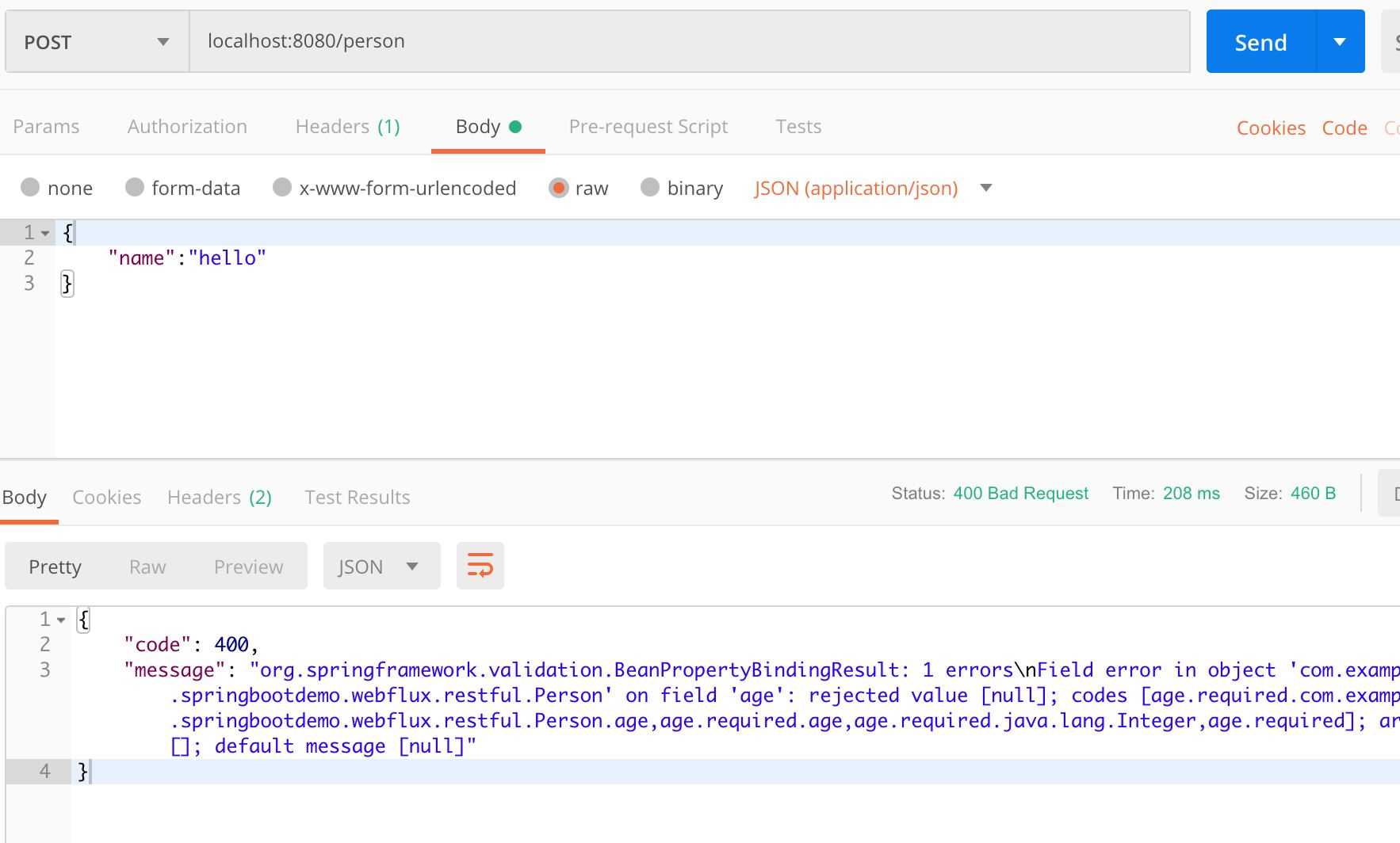Spring WebFlux實(shí)現(xiàn)參數(shù)校驗(yàn)的示例代碼
請求參數(shù)校驗(yàn),在實(shí)際的應(yīng)用中很常見,網(wǎng)上的文章大部分提供的使用注解的方式做參數(shù)校驗(yàn)。本文主要介紹 Spring Webflux Function Endpoint 使用 Spring Validation 來校驗(yàn)請求的參數(shù)。使用上一篇文章的示例來演示。
使用步驟如下:1.創(chuàng)建校驗(yàn)器 Validator
2.運(yùn)用校驗(yàn)器
3.拋出異常,返回 http status 400 錯(cuò)誤
PersonValidator.java
package com.example.springbootdemo.webflux.restful;import org.springframework.stereotype.Component;import org.springframework.validation.Errors;import org.springframework.validation.ValidationUtils;import org.springframework.validation.Validator;@Componentpublic class PersonValidator implements Validator { @Override public boolean supports(Class<?> clazz) { return Person.class.isAssignableFrom(clazz); } // 校驗(yàn)參數(shù)的方法 @Override public void validate(Object o, Errors errors) { ValidationUtils.rejectIfEmpty(errors, 'name', 'name.required'); ValidationUtils.rejectIfEmpty(errors, 'age', 'age.required'); Person p = (Person) o; if (p.getAge() != null && p.getAge() < 0) { errors.rejectValue('age', 'negative.value'); } else if (p.getAge() != null && p.getAge() > 200) { errors.rejectValue('age', 'too.old'); } }}
校驗(yàn)器在 savePerson 方法中的使用
@Slf4j@Componentpublic class PersonHandler { @Autowired private PersonRepository repository; @Autowired private PersonValidator validator; public Mono<ServerResponse> savePerson(ServerRequest request) { Mono<Person> personMono = request.bodyToMono(Person.class).doOnNext(this::validate); return ServerResponse.ok().contentType(MediaType.APPLICATION_JSON).body(this.repository.savePerson(personMono), Void.class); } public void validate(Person person) { Errors errors = new BeanPropertyBindingResult(person, Person.class.getName()); validator.validate(person, errors); if (errors.hasErrors()) {// 拋出 http status 400 異常 throw new ServerWebInputException(errors.toString()); } } // .... 省略}
請求效果:

官方校驗(yàn)參數(shù)示例的地址 https://docs.spring.io/spring-framework/docs/current/reference/html/web-reactive.html
使用 Spring 官方文檔提供的示例不會(huì)拋出 http code 400 錯(cuò)誤,返回的是http code 為 200。
接下來,我們來看一下Validator 接口中的兩個(gè)方法 supports 和 validate
supports(Class) : 判斷當(dāng)前的校驗(yàn)器用指定的類上。 validate(Object, org.springframework.validation.Errors) : 校驗(yàn)給定的對象,如果出現(xiàn)錯(cuò)誤,就給Errors 注冊 Error 信息。另外,Spring 還提供了非常好用的 ValidationUtils 的工具類,提供了靜態(tài)的方法
rejectIfEmpty rejectIfEmptyOrWhitespace全局異常的使用
@Configuration@Slf4jpublic class GlobalErrorConfig { private ObjectMapper objectMapper = new ObjectMapper(); @Bean @Order(-2) public WebExceptionHandler exceptionHandler() { return (ServerWebExchange serverWebExchange, Throwable t) -> { DataBuffer dataBuffer = serverWebExchange.getResponse().bufferFactory().allocateBuffer(); Result result = new Result(); if (t instanceof ServerWebInputException) {ServerWebInputException exception = (ServerWebInputException) t;result.setCode(exception.getStatus().value());result.setMessage(exception.getReason()); } else {result.setCode(HttpStatus.INTERNAL_SERVER_ERROR.value());result.setMessage(HttpStatus.INTERNAL_SERVER_ERROR.toString()); } try {dataBuffer.write(objectMapper.writeValueAsBytes(result)); } catch (JsonProcessingException e) {log.error(NestedExceptionUtils.buildMessage('write error', e)); } ServerHttpResponse response = serverWebExchange.getResponse(); response.setRawStatusCode(result.getCode()); return response.writeWith(Mono.just(dataBuffer)); }; }}
Result.java
import lombok.Getter;import lombok.Setter;@Getter@Setterpublic class Result { private Integer code; private String message;}
請求效果:

至此,Webflux 的Function Endpoint 的參數(shù)校驗(yàn)的使用結(jié)束了。
參考:
WebFlux Handler Validation
Spring Validator
到此這篇關(guān)于Spring WebFlux實(shí)現(xiàn)參數(shù)校驗(yàn)的示例代碼的文章就介紹到這了,更多相關(guān)Spring WebFlux 參數(shù)校驗(yàn)內(nèi)容請搜索好吧啦網(wǎng)以前的文章或繼續(xù)瀏覽下面的相關(guān)文章希望大家以后多多支持好吧啦網(wǎng)!
相關(guān)文章:
1. Python函數(shù)參數(shù)中的*與**運(yùn)算符2. ThinkPHP6使用JWT+中間件實(shí)現(xiàn)Token驗(yàn)證實(shí)例詳解3. JSP出現(xiàn)中文亂碼問題解決方法詳解4. Python使用oslo.vmware管理ESXI虛擬機(jī)的示例參考5. Python如何解決secure_filename對中文不支持問題6. 使用python tkinter開發(fā)一個(gè)爬取B站直播彈幕工具的實(shí)現(xiàn)代碼7. ASP基礎(chǔ)入門第二篇(ASP基礎(chǔ)知識)8. python 定義函數(shù) 返回值只取其中一個(gè)的實(shí)現(xiàn)9. Python 用NumPy創(chuàng)建二維數(shù)組的案例10. 不使用XMLHttpRequest對象實(shí)現(xiàn)Ajax效果的方法小結(jié)

 網(wǎng)公網(wǎng)安備
網(wǎng)公網(wǎng)安備